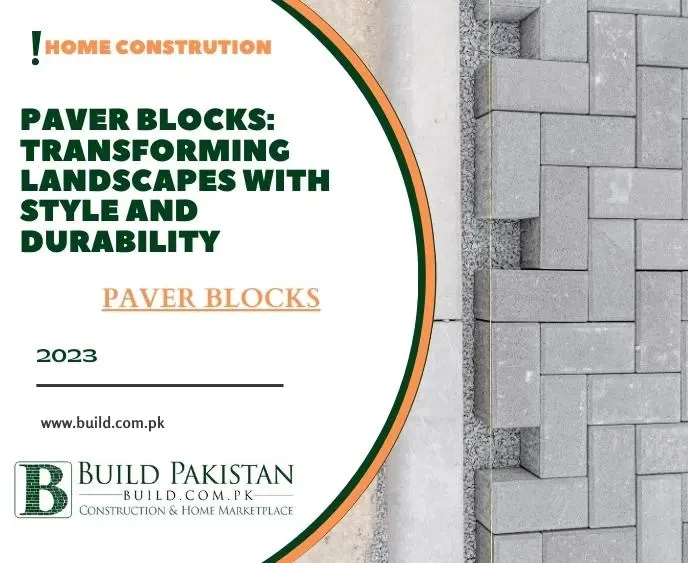Paver Blocks: Transforming Landscapes with Style and Durability

Introduction:
Paver blocks
have become synonymous with modern landscaping, offering a versatile and
aesthetically pleasing solution for a range of outdoor applications. This
comprehensive guide explores the world of paver blocks, delving into their
composition , benefits, design possibilities, installation process, and the
diverse ways in which they enhance outdoor spaces.
Understanding Paver Blocks:
Paver
blocks, also known as paving stones or concrete pavers, are manufactured
concrete units designed for use in exterior hardscaping. These blocks come in
various shapes, sizes, colors, and textures, providing a customizable and
durable alternate ve to traditional paving methods.

Key Components and Composition
Concrete Mix:
The primary
component of paver blocks is a carefully formulated concrete mix. This mix
typically includes cement, aggregates, and pigments. The proportions are
adjusted to achieve the desired strength and color.
Color Pigments:
Pigments are
added to the concrete mix to impart color to the paver blocks. This allows for
a wide range of color options, enabling customization to match the aesthetic
preferences of the landscaping design.
Molding and Texturing:
During the
manufacturing process, the concrete mix is poured into molds that determine the
shape and size of the paver blocks. Texturing may be applied to create surface
patterns such as cobblestone, brick, or slate textures.
Benefits of Paver Blocks
Durability:
Paver blocks
are renowned for their durability. The high-strength concrete mix ensures that
they can withstand the rigors of foot traffic, vehicular loads, and varying
weather conditions.
Design Flexibility:
The diverse
range of shapes, sizes, and colors available in paver blocks allows for
unparalleled design flexibility. Whether creating intricate patterns or simple
layouts, pavers offer versatility in design.
Easy Maintenance:
Paver blocks
are relatively easy to maintain. In case of damage or staining, individual
blo cks can be replaced without disturbing the entire paved surface. Regular
cleaning is usually sufficient to keep them looking fresh.
Permeability:
Some paver
block designs incorporate permeable features, allowing water to pass through
the surface. This can be beneficial for managing stormwater runoff and
preventing puddles or flooding.
Cost-Effective:
Paver blocks
are a cost-effective paving solution, considering their durability and the ease
of maintenance. The initial investment often pays off in the long run due to
reduced repair and replacement costs.
Applications of Paver Blocks
Driveways
and Walkways:
Paver blocks
are commonly used for driveways and walkways, providing a durable and visually
appealing surface for both pedestrian and vehicular traffic.
Patios and
Courtyards:
Creating
inviting outdoor spaces is made easy with paver blocks. Patios and courtyards
can be transformed into stylish and functional areas for relaxation and
entertainment.
Garden
Paths:
Paver blocks
are an excellent choice for garden paths, adding structure and definition to
landscaping while allowing for efficient water drainage.
Pool Decks:
The non-slip
properties of many paver block designs make them ideal for pool decks. They
p rovide a safe and comfortable surface around swimming pools.
Public
Spaces:
Paver blocks
are frequently used in public spaces such as parks, plazas, and pedestrian
zones. Their durability and design options make them suitable for enhancing the
aesthetics of urban areas.
Installation Process
Excavation
and Base Preparation:
The area is
excavated to the required depth, and a base layer of crushed stone or gravel is
compacted to create a stable foundation.
Edge
Restraints:
Edge restraints
are installed to contain the paver blocks and prevent spreading. These can be
made of materials like concrete or plastic.
Bedding
Sand:
A layer of
bedding sand is spread over the compacted base to provide a level surface for
laying the paver blocks.
Laying
Pavers:
Paver blocks
are carefully laid in the desired pattern or design. Proper spacing is
maintained, and adjustments are made to ensure a level surface.
Joint Sand
and Compaction:
Joint sand
is spread over the laid pavers, and the entire surface is compacted. This helps
to fil l the joints between the blocks, stabilizing the installation.
Design Possibilities and Trends
Herringbone
Patterns:
Herringbone
patterns continue to be a popular choice, providing a classic and visually
interesting layout.
Mixed
Materials:
Combining
different materials, such as pavers with natural stone or grass, adds texture
and visual interest to outdoor spaces.
Contemporary
Geometrics:
Modern
landscapes often feature geometric patterns, using paver blocks to create clean
lines and sophisticated designs.
Color
Blending:
Blending
different colors within the same design allows for a customized and visually
dynamic paving solution.
Conclusion:
In conclusion, paver blocks stand as a cornerstone in modern landscaping, offering a harmonious blend of durability, design flexibility, and ease of maintenance. From driveways to patios, their applications are vast and diverse. The evolution of manufact uring techniques and design trends continues to propel paver blocks into the forefront of outdoor paving solutions. As homeowners, landscapers, and urban planners seek sustainable and visually appealing options, paver blocks emerge as a timeless choice, transforming landscapes with style and enduring charm. Whether embracing classic patterns or exploring contemporary designs, the versatility of paver blocks ensures they will continue to shape outdoor spaces for years to come.









